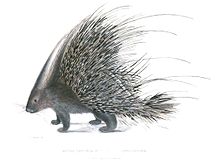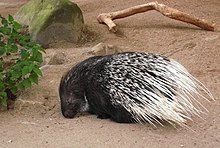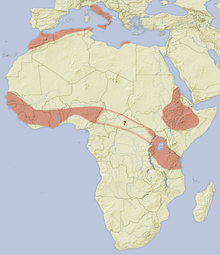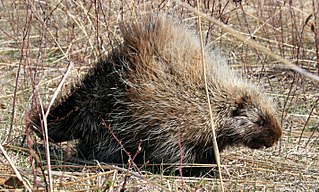
Porcupines are large rodents with coats of sharp spines, or quills, that protect them against predation. The term covers two families of animals: the Old World porcupines of the family Hystricidae, and the New World porcupines of the family Erethizontidae. Both families belong to the infraorder Hystricognathi within the profoundly diverse order Rodentia and display superficially similar coats of rigid or semi-rigid quills, which are modified hairs composed of keratin. Despite this, the two groups are distinct from one another and are not closely related to each other within the Hystricognathi. The largest species of porcupine is the third-largest living rodent in the world, after the capybara and beaver.

The Old World porcupines, or Hystricidae, are large terrestrial rodents, distinguished by the spiny covering from which they take their name. They range over the south of Europe and the Levant, most of Africa, India, and Southeast Asia as far east as Flores. Although both the Old World and New World porcupine families belong to the infraorder Hystricognathi of the vast order Rodentia, they are quite different and are not particularly closely related.
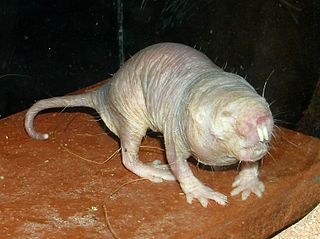
The naked mole-rat, also known as the sand puppy, is a burrowing rodent native to the Horn of Africa and parts of Kenya, notably in Somali regions. It is closely related to the blesmols and is the only species in the genus Heterocephalus.

The blind mole-rats, also known as the fossorial or subterranean mole rats, are a subfamily (Spalacinae) of rodents in the family Spalacidae, found in eastern Europe and western and central Asia. The hystricognath mole-rats of the family Bathyergidae are completely unrelated, but some other forms are also in the family Spalacidae. Zokors, root rats, and bamboo rats are spalacids also sometimes referred to as mole rats.

The blesmols, also known as mole-rats, or African mole-rats, are burrowing rodents of the family Bathyergidae. They represent a distinct evolution of a subterranean life among rodents much like the pocket gophers of North America, the tuco-tucos in South America, or the Spalacidae from Eurasia.

The Cape porcupine, Cape crested porcupine or South African porcupine, is a species of Old World porcupine native to central and southern Africa.

The Indian crested porcupine is a hystricomorph rodent species native to southern Asia and the Middle East. It is listed as Least Concern on the IUCN Red List. It belongs to the Old World porcupine family, Hystricidae.
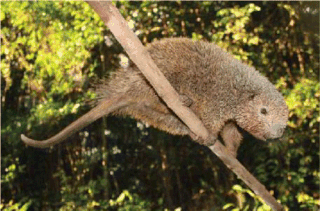
The bristle-spined rat is an arboreal rodent from the Atlantic forest in eastern Brazil. Also known as the bristle-spined porcupine or thin-spined porcupine, it is the only member of the genus Chaetomys and the subfamily Chaetomyinae. It was officially described in 1818, but rarely sighted since, until December 1986, when two specimens - one a pregnant female - were found in the vicinity of Valencia in Bahia. Since then it has been recorded at several localities in eastern Brazil, from Sergipe to Espírito Santo, but it remains rare and threatened due to habitat loss, poaching and roadkills.

Hystrix is a genus of porcupines containing most of the Old World porcupines. Fossils belonging to the genus date back to the late Miocene of Africa.
The wildlife of Iraq includes its flora and fauna and their natural habitats. Iraq has multiple biomes from mountainous region in the north to the wet marshlands along the Euphrates river. The western part of the country is mainly desert and some semi-arid regions. As of 2001, seven of Iraq's mammal species and 12 of its bird species were endangered. The endangered species include the northern bald ibis and Persian fallow deer. The Syrian wild ass is extinct, and the Saudi Arabian dorcas gazelle was declared extinct in 2008.
Choa Saidan Shah, is a town and Tehsil of Chakwal District in the Punjab Province of Pakistan. It is the capital and of one of the seven Union Councils of Choa Saidan Shah Tehsil.

Rodents are mammals of the order Rodentia, which are characterized by a single pair of continuously growing incisors in each of the upper and lower jaws. About 40% of all mammal species are rodents. They are native to all major land masses except for New Zealand, Antarctica, and several oceanic islands, though they have subsequently been introduced to most of these land masses by human activity.

Rochelle Buffenstein is an American comparative biologist currently working as Research Professor at the University of Illinois Chicago. Previously, she was a senior principal investigator at Calico Life Sciences, an Alphabet, Inc. funded research and development company investigating the biology that controls aging and lifespan where she used the extraordinarily long-lived cancer resistant naked mole-rat as an attractive counter-example to the inevitability of mammalian aging; for at ages greatly exceeding the expected maximum longevity for this mouse-sized rodent, they fail to exhibit meaningful changes in age-related risk of dying or physiological decline. As such these rodents likely provide the blueprint for how to stave off myriad adverse effects of aging and provide proof of concept that age-related health decline can be avoided in humans.

May Be’ati is an exclosure located in the Dogu'a Tembien woreda of the Tigray Region in Ethiopia. The area has been protected since 1968 by the local community.
